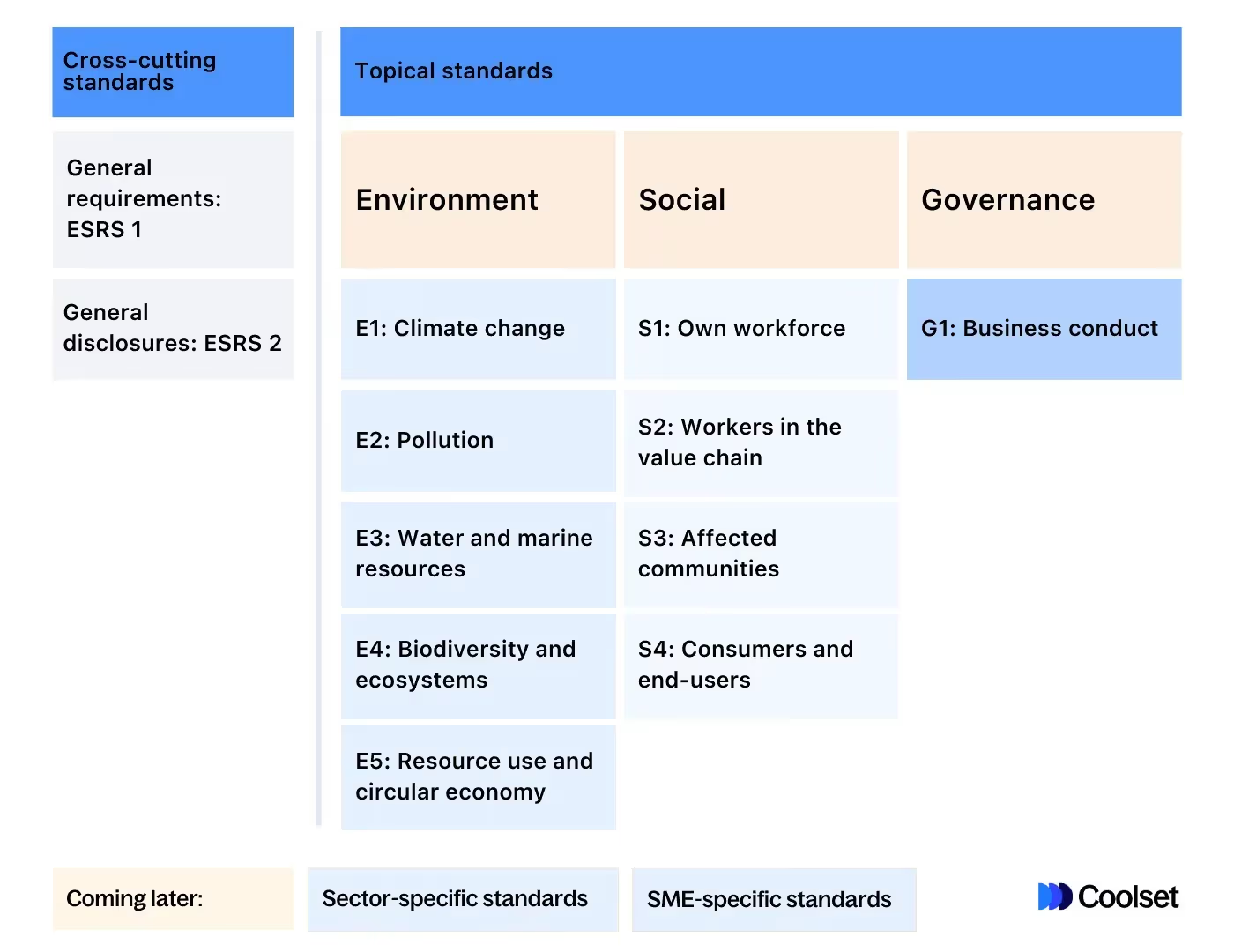Disclaimer: New EUDR developments - December 2025
In November 2025, the European Parliament and Council backed key changes to the EU Deforestation Regulation (EUDR), including a 12‑month enforcement delay and simplified obligations based on company size and supply chain role.
Key changes proposed:
These updates are not yet legally binding. A final text will be confirmed through trilogue negotiations and formal publication in the EU’s Official Journal. Until then, the current EUDR regulation and deadlines remain in force.
We continue to monitor developments and will update all guidance as the final law is adopted.
Disclaimer: 2026 Omnibus changes to CSRD and ESRS
In December 2025, the European Parliament approved the Omnibus I package, introducing changes to CSRD scope, timelines and related reporting requirements.
As a result, parts of this article may no longer fully reflect the latest regulatory position. We are currently reviewing and updating our CSRD and ESRS content to align with the new rules.
Key changes include:
We continue to monitor regulatory developments closely and will update this article as further guidance and implementation details are confirmed.
The European Sustainability Reporting Standards (ESRS), a key component of the Corporate Sustainability Reporting Directive (CSRD), mark a significant advance in sustainability reporting within the EU. These standards are central to the EUs sustainable finance agenda, aiming to enhance the transparency and comparability of sustainability information disclosed by companies. By requiring detailed reporting on environmental, social, and governance (ESG) aspects, the ESRS facilitate informed decision-making by investors, consumers, and other stakeholders.
A distinctive element of the ESRS is the "double materiality" concept, which mandates companies to assess and report on the impact of sustainability issues on their operations and their impact on society and the environment. This dual approach ensures a comprehensive understanding of a company's sustainability footprint and its financial implications.
The ESRS are designed to be inclusive, covering a wide range of entities, from large corporations to listed SMEs in the EU, and extending to non-EU companies with significant EU operations from 2028. This broad applicability underscores the EU's commitment to fostering a sustainable economic environment that addresses climate and environmental challenges comprehensively.
In this guide, we explain what the individual topics are, how they relate to double materiality, and how you can get started.
The ESRS were formally launched on July 31, 2023, when the European Commission adopted the first set of standards. This move marked a significant milestone in the EU's agenda for sustainable finance, embodying a comprehensive approach to integrate sustainability considerations into corporate reporting across the union.
The adoption of the ESRS was part of the broader CSRD, which aims to enhance the consistency and comparability of sustainability information provided by companies. By establishing a unified framework for sustainability reporting, the ESRS seek to address the critical need for reliable and accessible data on corporate sustainability performances.
Building on the foundations of the Non-Financial Reporting Directive (NFRD), the CSRD was developed to provide better transparency regarding businesses' sustainability impacts and to give stakeholders a more well-rounded understanding of a company's activities.
While the NFRD covered around 11,000 large companies across the EU, the CSRD has expanded this scope to nearly 71,000 businesses including all large and publicly listed companies – even listed SMEs.
The wider scope and inclusivity of the CSRD reflects a growing recognition of the role businesses play in tackling global sustainability challenges. It signals a shift to a business environment where transparency, accountability, and proactive engagement in sustainability are no longer just nice-to-haves, but non-negotiable aspects of running a business.
Established in 2001, the European Financial Reporting Advisory Group (EFRAG) is a private association known for its role in advising on EU financial matters. It was tasked by the European Commission to develop the ESRS.
To ensure the standards addressed the needs of all relevant parties, EFRAG consulted with various stakeholders including businesses, investors, and civil society organizations. It then presented draft standards that underwent a public consultation process which allowed for feedback and refinements.
On July 31, 2023, the final set of standards was adopted by the EC marking a huge milestone for corporate sustainability reporting in Europe. EFRAG will continue to develop and refine the ESRS to ensure the standards remain relevant and effective.
2024: Large companies already reporting under the NFRD will transition to CSRD standards starting in 2024 (reporting in 2025).
2025: Large companies meeting two of the following criteria must comply with the CSRD in 2025 (reporting in 2026): 250+ employees, €50m+ net turnover, €25m+ total assets.
2026: Listed small-to-medium enterprises (SMEs) that meet two of the following criteria must comply with the CSRD in 2026 (reporting in 2027): small-sized (50-249 employees, €10-50m net turnover, €5-25m total assets) or micro-sized (10-49 employees, €900k-10m net turnover, €450k-5m total assets).
Third-country undertakings must comply with the CSRD by 2028 (reporting in 2029).
{{custom-cta}}
The European Commission’s Omnibus Proposal, published in February 2025, introduces significant changes that could delay and narrow the CSRD’s application. If adopted, the proposal would raise the employee threshold for large undertakings from 250 to 1,000, potentially exempting tens of thousands of companies from ESRS reporting requirements. It also suggests deferring the reporting deadlines for companies in the second and third rollout phases by two years—until 2028 and 2029, respectively.
These changes aim to reduce administrative burden and give businesses more time to prepare. However, they may also dilute the CSRD’s ambition and slow progress on the EU’s sustainable finance agenda. For companies preparing for ESRS compliance, the proposal introduces uncertainty and could affect planning, resource allocation, and stakeholder expectations. The final impact will depend on whether and how the European Parliament and Council adopt the Omnibus amendments.

The ESRS was designed to apply to companies based in the EU. The standards also apply to multinational companies with significant operations or listings in the EU. This means the ESRS extends globally, influencing many countries worldwide.
The ESRS applies to companies across all economic sectors, from manufacturing to finance to services or technology.
While the initial focus is on large publicly listed companies, certain provisions extend to SMEs. The ESRS also includes public interest entities such as banks and insurance companies given their large social and economic impact.
The ESRS framework covers a broad range of topics – 12 to be exact – to ensure companies report on crucial sustainability aspects in a standardized way. Here’s an overview of the two cross-cutting standards, the ten primary topics, and entity-specific aspects:
The ESRS contains two cross-cutting standards, ESRS 1 and ESRS 2, which lay the foundation for effective reporting across all sectors. This means that these ESRS metrics are always to be reported on, regardless of the outcome of the double materiality assessment.
ESRS 1 describes the minimum reporting requirements so that it’s easy to understand a company’s impacts, risks, and opportunities related to ESG aspects. This covers topics such as governance, strategy, business model, risk management, and company objectives.
It also outlines other information required about a company and its organization, what information is not yet mandatory to report, and what is meant by double materiality (more on this soon).
Note that this ESRS doesn’t include actual metrics to report on - these are included in ESRS 2.
ESRS 2 details the disclosure requirements for preparing a thorough sustainability statement and applies to all companies.
It requires information on governance structures, strategies, materiality assessments, and performance indicators and targets, including the value chain coverage.
It also requires information on stakeholder engagement and the media analysis, two central elements of the research phase of the double materiality assessment.
The first set of ESRS contains 10 topical standards focusing on environmental, social, and governance (ESG) matters.
ESRS E1 - Climate change: Addressing greenhouse gas (GHG) emissions, climate risks, and mitigation strategies.
ESRS E2 - Pollution: Reporting on waste management, emissions, and pollution control measures.
ESRS E3 - Water and marine resources: Covering water usage, conservation, and impact on aquatic ecosystems.
ESRS E4 - Biodiversity and ecosystems: Including impacts on ecosystems and biodiversity conservation efforts.
ESRS E5 - Resource use and circular economy: Focusing on sustainable resource use, recycling, and circular economy practices.
ESRS S1 - Own workforce: Addressing issues related to human rights protections in business operations.
ESRS S2 - Workers in the value chain: Including employee rights, labor standards, and workplace conditions.
ESRS S3 - Affected communities: Covering ethical business practices, anti-corruption measures, and compliance.
ESRS S4 - Consumers and end-users: Relating to product safety, customer satisfaction, and consumer rights.
ESRS G1 - Business conduct: Encompassing corporate governance structures, board responsibilities, and stakeholder engagement.

Not all ESRS topics have to be included in a company’s annual sustainability report – only those that are material to a company. A topic can be material from an impact or financial perspective. To understand which topics to include, companies must conduct a double materiality assessment.
The EFRAG defines double materiality as “the union of impact materiality and financial materiality.” As such, it’s a principle that evaluates sustainability topics from these two perspectives:
Impact materiality (inside-out):
How a company's actions impact the environment and society.
Financial materiality (outside-in):
How environmental and social issues affect the company's financial health.
A sustainability matter (i.e. one of the 10 ESRS topics or an entity-specific topic) meets the double materiality criteria if it is material from either the impact perspective, the financial perspective, or both perspectives.

The ESRS includes a methodology on how double materiality should be assessed.
Companies must first define their relevant ESG topics and identify the impacts, risks, and opportunities (IROs) along the entire value chain.
They then need to assess the IROs based on the ESRS’s assessment processes.
Finally, they must identify which topics are material. Using a materiality matrix can help companies visually prioritize and clarify the significance of various sustainability topics. Results should then be included in the company's ESG strategy and reporting.
We have also published an extensive guide on the double materiality assessment, which you download here.
{{product-tour-injectable}}
As of now, the ESRS doesn’t include sector-specific standards. EFRAG is expected to introduce sector-specific standards as part of the second set of ESRS, although their publication has been delayed by two years and is now anticipated around mid-2026. These will provide more detailed and relevant reporting content for different industries.
There are also no specific standards for SMEs in the current ESRS framework. Future updates will likely address this gap, offering SMEs a more practical and proportionate approach to sustainability reporting. There are also voluntary standards in the works for non-listed SMEs. Note that the Omnibus Proposal recommends scrapping both sector-specific standards as well as SME standards.
The CSRD requires companies to publish and file annual reports in a digital format under the guidelines of the European Single Electronic Format (ESEF).
The ESEF prescribes the use of XHTML (eXtensible HyperText Markup Language), and for the CSRD specifically, the use of inline XBRL (eXtensible Business Reporting Language). This combination ensures reports are readable by both humans and machines.
Companies must digitally ‘tag’ sustainability information according to XBRL’s categorization system. With over 1000 data points across a range of categories – from GHG emissions to water & energy consumption to pollution, etc. – the system makes it easier to reference and analyze data.
This recent PowerPoint from EFRAG provides a clear introduction to Inline XBRL and how it's used (slides 12 and 14-15). Good to know: technical guidelines for implementing the machine readability of ESRS statements are currently in the works.
While the ESRS looks promising in terms of creating more responsible corporate practices in Europe, adapting to these standards is no simple feat. Here are some challenges companies might face along with some criticisms of the ESRS in its current state:
Rapid implementation timeline: The deadline to adapt to the CSRD (and ESRS) is approaching fast – some companies are required to comply as early as this year! This swift transition can be overwhelming, especially for businesses new to sustainability reporting. Download our free CSRD cheat sheet to start your compliance journey today.
Investment in sustainability teams: Reporting under the CSRD is complex and requires employees with specialized knowledge and skills. Building or expanding your sustainability team requires financial investments which can be particularly tricky for smaller companies.
Unfinalized standards: As of now, the ESRS are not yet finalized. The second set which will include sector-specific standards is expected to be adopted by the EC by 20 June 2024. The incomplete status can make it hard for companies to fully prepare their reporting strategies. This means businesses must remain agile and adjust their processes once the final standards are published.
Complexity and scope: The CSRD and ESRS are intricate frameworks that cover a wide range of topics. This can be overwhelming for companies, particularly those new to such detailed reporting requirements.
Reporting under the ESRS requirements is no easy feat. With over 1000 datapoints to assess, many stakeholders to engage and weeks of research to get started with - it can quickly become overwhelming.
Coolset can help your company streamline the process. By reporting on all the ESRS topics on our platform, we set you up with an audit-ready CSRD report. Get in touch with one of our experts.
Understand the key changes introduced by the Omnibus Proposal and learn how to move forward with confidence under the evolving EU sustainability legislation

What changed in EFRAGs new ESRS dataset, and what stayed the same
